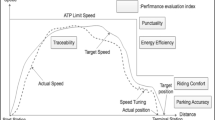Abstract
This paper designs the performance index of the automatic train operation (ATO) speed curve model. In addition, based on the principle of genetic algorithm, it optimizes the ATO speed curve. At last, combined with train operation route and train parameters, we design the optimization process of the ATO speed curve in details. System speed protection index, punctuality index, accurate parking index, comfort index and energy saving index meet the requirements, and at the same time achieve the purpose of optimal optimization. The result of this paper shows that using the characteristics of global optimization of genetic algorithm has significant advantages in solving the optimization of complex nonlinear ATO speed curve. Therefore, it can be concluded that it is feasible and advantageous to apply genetic algorithm to the optimization of ATO speed curve, which has reference value in the practical application of ATO speed curve optimization.




Similar content being viewed by others
References
Gao, S., Dong, H., Ning, B., Chen, Y., & Sun, X. (2015). Adaptive fault-tolerant automatic train operation using RBF neural networks. Neural Computing and Applications, 26(1), 141–149.
Asuka, M., Kataoka, K., Komaya, K., & Nishida, S. (2015). Automatic train operation using autonomic prediction of train runs. Electrical Engineering in Japan, 175(3), 65–73.
Ganesan, M., Ezhilarasi, D., & Benni, J. (2017). Second-order sliding mode controller with model reference adaptation for automatic train operation. Vehicle System Dynamics, 1, 1–23.
Watanabe, S., & Koseki, T. (2015). Energy-saving train scheduling diagram for automatically operated electric railway. Journal of Rail Transport Planning & Management, 5(3), 183–193.
Ganesan, M., Ezhilarasi, D., & Benni, J. (2017). Hybrid model reference adaptive second order sliding mode controller for automatic train operation. IET Control Theory and Applications, 11(8), 1222–1233.
Li, Z., & Hou, Z. (2015). Adaptive iterative learning control based high speed train operation tracking under iteration-varying parameter and measurement noise. Asian Journal of Control, 17(5), 1779–1788.
Zhang, D., & Qian, D. (2017). Study on leader-follower control in the metro unattended train operation. In International conference on advanced mechatronic systems (pp. 179–183). IEEE.
Shi, H., Peng, Q., & Guo, H. (2015). Improved GA of train operation simulation model. International Conference on Transportation Engineering, 19, 1708–1713.
Xiao, S., Li, W., & Shang, T. (2017). Fuzzy logic based high speed data transmission algorithm of sensor networks for target tracking. Journal of Intelligent & Fuzzy Systems, 33(5), 2887–2893.
Acknowledgements
The authors acknowledge the National Natural Science Funds of China (Grant: 51674245), Research and Practice Project on the Reform of Graduate Education and Teaching in China University of Mining and Technology (Grant: 2017Y05), and the Natural Science Foundation of Jiangsu Province (Grant: BK20150193).
Author information
Authors and Affiliations
Corresponding author
Rights and permissions
About this article
Cite this article
Wang, G., Xiao, S., Chen, X. et al. Application of Genetic Algorithm in Automatic Train Operation. Wireless Pers Commun 102, 1695–1704 (2018). https://doi.org/10.1007/s11277-017-5228-6
Published:
Issue Date:
DOI: https://doi.org/10.1007/s11277-017-5228-6




